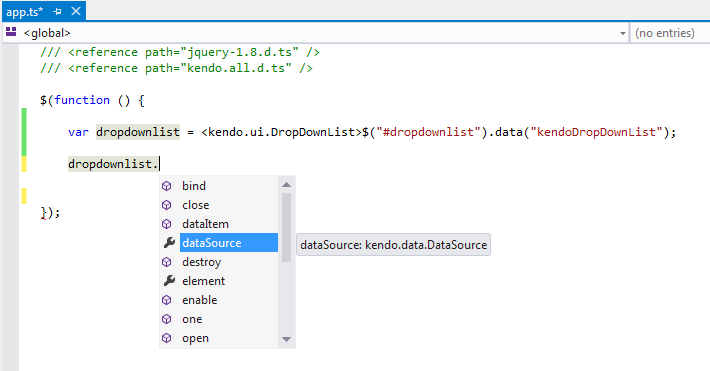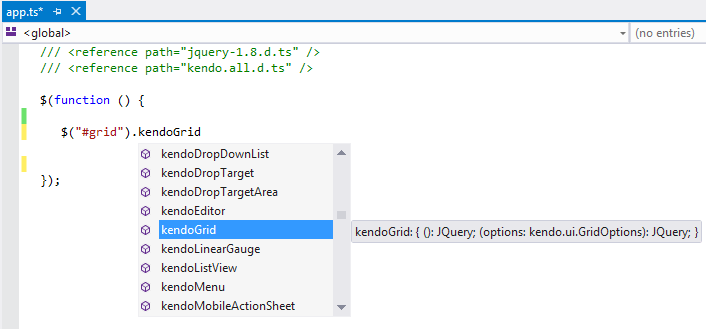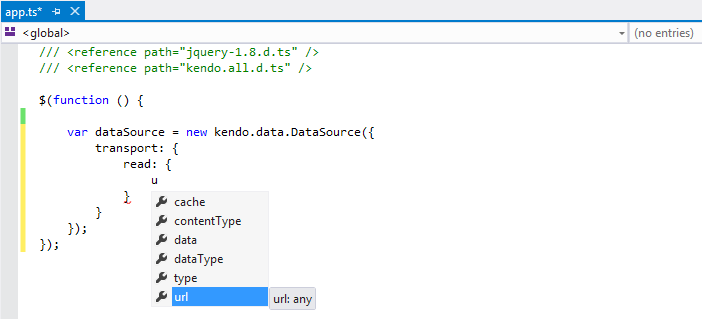TypeScript
Kendo UI provides a TypeScript definitions file which enables strongly-typed access to the Kendo UI components and their configuration.
Getting Started
You can install TypeScript either by using the redistributable package or NPM.
Using the Redistributable Package
Each Kendo UI distribution includes a typescript directory which contains a .d.ts file, i.e. kendo.all.d.ts. Copy this file to your project and in your TypeScript file add a reference to it as demonstrated below:
/// <reference path="kendo.all.d.ts" />You can optionally include the latest jQuery TypeScript definition file as well.
/// <reference path="jquery-1.8.d.ts" />
/// <reference path="kendo.all.d.ts" />Using NPM
When you install Kendo UI for jQuery through NPM, the package already includes all TypeScript definition files. No additional installation is required. After running:
npm install --save @progress/kendo-ui
the TypeScript definitions (including all.d.ts) are available directly inside the installed NPM package.
Features
-
Getting instances of existing components

-
Initializing and configuring components

-
Initializing the Kendo UI DataSource

-
Creating components through TypeScript inheritance—The following example demonstrates how to inherit from an existing Kendo UI component.
/// <reference path="jquery.d.ts" />
/// <reference path="kendo.all.d.ts" />
module KendoWidgets {
// (Optional) Extend the default component options.
export interface MyDatePickerOptions extends kendo.ui.DatePickerOptions {
}
// Create a class which inherits from the Kendo UI component.
export class MyDatePicker extends kendo.ui.DatePicker {
constructor(element: Element, options?: MyDatePickerOptions) {
super(element, options);
}
// (Optional) Override a component method.
open() {
// Log to the console (optional).
console.log("open");
// Invoke a base component method.
super.open();
}
}
// Create an alias of the prototype (required by kendo.ui.plugin).
MyDatePicker.fn = MyDatePicker.prototype;
// Deep clone the component default options.
MyDatePicker.fn.options = $.extend(true, {}, kendo.ui.DatePicker.fn.options);
// Specify the name of your Kendo UI component. Used to create the corresponding jQuery plugin.
MyDatePicker.fn.options.name = "MyDatePicker";
// Create a jQuery plugin.
kendo.ui.plugin(MyDatePicker);
}
// Expose the newly created jQuery plugin to TypeScript.
interface JQuery {
kendoMyDatePicker(options?: kendo.ui.DatePickerOptions): JQuery;
}
$(function () {
// Initialize your custom component.
$("#datepicker").kendoMyDatePicker();
// Get a reference to the component instance.
var myDatePicker = <KendoWidgets.MyDatePicker>$("#datepicker").data("kendoMyDatePicker");
// Call a component method.
myDatePicker.open();
});- Using Kendo UI MVVM in TypeScript—When inheriting from
kendo.data.ObservableObjectin TypeScript you should call thesuper.initmethod to properly set up dependency tracking. The following example shows how to use Kendo UI MVVM in TypeScript.
/// <reference path="jquery.d.ts" />
/// <reference path="kendo.all.d.ts" />
class Person extends kendo.data.ObservableObject {
name = "John Doe";
constructor() {
super();
super.init(this);
}
}
class ViewModel extends kendo.data.ObservableObject {
person = new Person();
constructor() {
super();
super.init(this);
}
}
$(function () {
var viewModel = new ViewModel();
kendo.bind(document.body, viewModel);
viewModel.set("person.name", "Jane Doe");
});